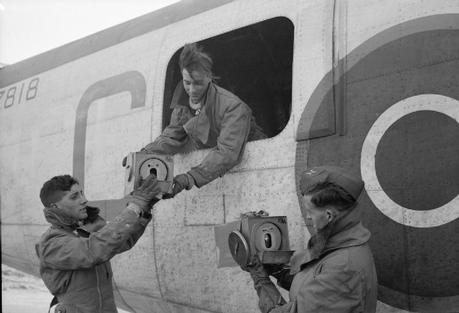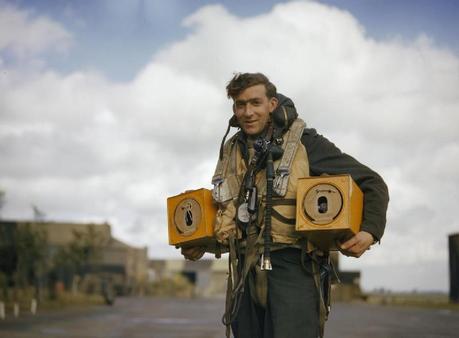Who Could Make This Up?
Yes, the Royal Air Force deployed homing pigeons or carrier pigeons on bombers and other planes in the event planes had to ditch in the sea. Theoretically, the carrier pigeons served as a method of emergency communication to send the position of the downed plane.
 Crewmen of Consolidated Liberator GR Mark VA, BZ818 'C', of No. 53 Squadron RAF handling carriers containing homing pigeons at St Eval, Cornwall, after a patrol over the Bay of Biscay. Sergeant J Knapp of Toronto, Canada, (in the hatchway) hands a carrier to Sergeant W Tatum of London, while Warrant Officer A Mackinnon of Auckland, New Zealand, holds a second carrier. Date between circa 1943 and circa 1944 (Caption and photo courtesy of the Imperial War Museum posted by Charles McCain on www.charlesmccain.com )
Crewmen of Consolidated Liberator GR Mark VA, BZ818 'C', of No. 53 Squadron RAF handling carriers containing homing pigeons at St Eval, Cornwall, after a patrol over the Bay of Biscay. Sergeant J Knapp of Toronto, Canada, (in the hatchway) hands a carrier to Sergeant W Tatum of London, while Warrant Officer A Mackinnon of Auckland, New Zealand, holds a second carrier. Date between circa 1943 and circa 1944 (Caption and photo courtesy of the Imperial War Museum posted by Charles McCain on www.charlesmccain.com ) The RAF Pigeon Service was established shortly before World War Twobecause RAF reconnaissance aircraft had begun flying longer missions and spending large amounts of time over the sea. if they got in trouble, radio communication from an aircraft worked relatively well as long as the aircraft was flying of at least 5,000 feet and preferably higher, especially if you were at the limit of your range.
This enabled the receiving end to get a good fix on your position. However, this only worked if the plane was in the air. Once below a certain altitude and most certainly after they hit the water, the aircraft's long range transmitter would not work.
If the pilot announced he was going to ditch the aircraft into the water, then the radio operator began signalling the position of the aircraft as well as transmitting "Mayday." War made all of this more difficult.
In war, British planes were often attacked by German fighters. If the RAF bomber had sustained critical damage in the engagement and could not remain in the air long enough to make it home, then the pilot would ditch into the English Channel.
Facts in this post are drawn from a brief description of the Pigeon Service in the book:
Shot Down and in the Drink: RAF and Commonwealth Aircrews Saved from the Sea 1939 to 1945 by Air Commodore Graham Pitchfork (published by the National Archives of the United Kingdom in 2005) and from the Imperial War Museum.

Author Bio: My first novel, An Honorable German, about a heroic and conflicted German U-Boat Commander, was published in May 2009 right after I survived a bout with lymphoma. Through the Grace of God and the brilliance of Dr. Wydham Wilson, PhD, MD and his deputy genius, Kieron Dunleavy, MD, of the lymphoma team of the National Cancer Institute, I was cured and have spent the time since recovering and working on both my blog and future works.
